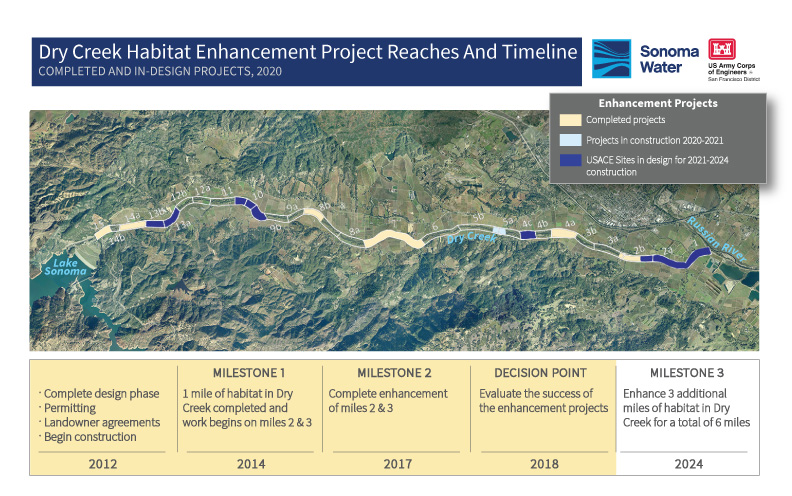Background
The Russian River Biological Opinion (issued in 2008 by National Marine Fisheries Service) requires Sonoma Water and the U.S. Army Corps of Engineers (USACE) to provide hiding places and refuge in Dry Creek for young coho salmon and steelhead trout. While the cold, clean water in Dry Creek is ideal for salmon and steelhead, the water moves too fast for young fish to thrive. The Biological Opinion requires that six miles of habitat be constructed in the 14-mile long creek. The first mile of restoration, which includes logs, boulders, and thousands of native plants was completed in 2014.
Starting in 2010, Sonoma Water has worked with a willing group of landowners – including Amista Vineyards, Dry Creek Vineyard, the Seghesio Family, Rued Winery, Quivira Vineyards and Winery, Yellow Dog Vineyard, Doug Lipton, Carole & Geno Mascherini, Peter & Marian Van Alyea and Ron Wolmer – to construct about one mile of habitat restoration above and below Lambert Bridge.
The purpose of the project is to demonstrate to regulators, landowners, and local decision makers the feasibility of Dry Creek habitat restoration on a smaller scale and, in particular, to determine how they could be constructed, what they may ultimately look like, and how effective they are before implementing the full six miles of habitat restoration on Dry Creek.
- Download a flyer on Dry Creek Habitat Restoration Demonstration Project
- Download Conceptual Design Report (July 2012)
- Phase 4 99% Construction Plans (July 2020)
- Phase 5 99% Construction Plans (July 2020)
- Phase 6 99% Construction Plans (July 2020)
What's Been Built and What Is Planned

Work Completed in Summer of 2016
Work on the Dry Creek Habitat Restoration Project made significant progress last summer with more than a half mile of habitat restoration features being completed. Construction crews in 2017 will take up where they left off last year as Sonoma Water continues to work toward the goal of enhancing a total of six miles of Dry Creek habitat to improve conditions for endangered coho salmon and threatened steelhead.
Two large habitat features on the Truett Hurst Winery, Meyer family, and Williamson Winery properties were completed during last summer’s construction season. In 2017, construction is planned on two additional habitat features just downstream from Truett Hurst, spanning the property of the Meyer family, Carlson Family, and Lone Star Vineyards. Habitat construction will also continue just downstream of the Westside Road Bridge on property owned by the City of Healdsburg and the DaVero Farms & Winery.
 A side channel was built on the Truett Hurst property. |  View looking downstream from the Truett Hurst property. |

The downstream end of a side channel on the Meyer property (on the right) re-connects with the main channel of Dry Creek.

Construction of a side channel (above) was completed last summer on the Orsi property downstream of the Westside Road Bridge.
The habitat restoration features planned for these sites include side channels, riffles, backwaters and alcoves to slow the speed of the water and create refuge for young fish. The features will be constructed using natural materials such as logs and rocks. Bank stabilization measures will prevent or reduce erosion and provide vegetation cover.
Watch a video of December 2012's high flows in Dry Creek. Principal Program Specialist Dave Manning tells us why fish like the new backwater channel located at Quivira Winery. Sonoma Water is working with a willing group of Dry Creek landowners on a one-mile habitat restoration demonstration project. The purpose of the project is to demonstrate to regulators, landowners, and local decision makers the feasibility of Dry Creek habitat restoration on a smaller scale and, in particular, to determine how they could be constructed, what they may ultimately look like, and how effective they are before implementing the full six miles of habitat restoration on Dry Creek. The project is centered on Lambert Bridge, near the middle of Dry Creek.
On November 15, 2011, the Sonoma Water Board of Directors approved the demonstration project and the environmental document (described below) analyzing the project.
Dry Creek Habitat Restoration Demonstration Project - Flier (PDF)
Initial Study and Mitigated Negative Declaration for the Habitat Restoration Demonstration Project
Sonoma Water is the Lead Agency under the California Environmental Quality Act (CEQA) for the proposed Dry Creek Habitat Restoration Demonstration Project (Dry Creek Demonstration Project). Sonoma Water prepared an Initial Study and Mitigated Negative Declaration (Initial Study) for the project in accordance with CEQA. Sonoma Water’s Board of Directors approved the Initial Study on November 15, 2011.
Environmental Impact Report Prepared for Miles 2-6
Sonoma Water prepared a Draft Environmental Impact Report (Draft EIR) to disclose the potential environmental impacts of the proposed Dry Creek Habitat Restoration Project, Miles 2-6. The Draft EIR is available electronically on our Environmental Documents webpage.
Sonoma Water and their contractors, ESA PWA and Interfluve, have been conducting site surveys since March 2014 to determine feasible project sites for the remaining five miles of habitat restoration on Dry Creek. Preliminary concepts are currently in development.
Elements of the Dry Creek habitat restoration projects include bank stabilization to reduce erosion, anchored boulders to create riffles (small rapids that increase the amount of oxygen in the water), anchored log jams to provide refuge and to slow the water, constructed backwaters and side channels to give the young fish places to escape high flows and native plants to reduce erosion and create shade.
Dry Creek Habitat Restoration Bulletin
 In an effort to keep local residents and potential project partners informed about the Dry Creek Habitat Restoration Project, Sonoma Water publishes the Dry Creek Habitat Restoration Bulletin. The six-page newsletter provides background information on the need for the habitat project, progress on habitat restoration, details about how Sonoma Water is measuring the success of the project, and profiles of some of the property owners participating in the project.
In an effort to keep local residents and potential project partners informed about the Dry Creek Habitat Restoration Project, Sonoma Water publishes the Dry Creek Habitat Restoration Bulletin. The six-page newsletter provides background information on the need for the habitat project, progress on habitat restoration, details about how Sonoma Water is measuring the success of the project, and profiles of some of the property owners participating in the project.
You can read the bulletin here:
- Dry Creek Habitat Restoration Bulletin, Vol. 4 Summer 2017
- Dry Creek Habitat Restoration Bulletin, Vol. 3 Winter 2017
- Dry Creek Habitat Restoration Bulletin, Vol. 2 Summer 2016
- Dry Creek Habitat Restoration Bulletin, Vol. 1 Fall 2015
Safe Harbor Agreement
The Dry Creek Safe Harbor Agreement (SHA) is a voluntary agreement with landowners who are participating in the Dry Creek Habitat Restoration Project. The SHA provides these landowners with additional protections under the Endangered Species Act. Dry Creek Vineyard was the first landowner to sign-up for the SHA.
- A Landowner’s guide to Dry Creek Habitat Restoration “Safe Harbor” Agreement
- Watch the video explaining the Safe Harbor Agreement
Salmon Stewards of Dry Creek Program Acknowledges Landowner Cooperation
In recognition of their extraordinary stewardship and commitment to the health of the creek, Sonoma Water is recognizing landowners participating in the Dry Creek Habitat Restoration Project as "Salmon Stewards of Dry Creek." Thanks to their participation, young coho salmon and steelhead now have multiple areas of refuge from the high flows in the creek. Landowners who participate in the habitat restoration project can display the Salmon Steward of Dry Creek sign on their property to indicate to their customers and neighbors that they support the project. Michael and Vicky Farrow (at right) display their Salmon Steward of Dry Creek sign outside their tasting room at Amista Vineyards. The Farrows participated in the Demonstration Project that was started in 2010.
Annual Dry Creek Community Meeting
The annual Dry Creek Community Meeting was held February 15, 2017 at the Lake Sonoma Visitors Center. Representatives from Sonoma Water and the US Army Corps of Engineers provided the community with an update on the Dry Creek Habitat Restoration Project. The meeting was well attended and Fourth District Supervisor James Gore facilitated a lively discussion.
The presentation can be viewed here: 2017 Dry Creek Community Meeting Presentation
Dry Creek Advisory Group
The Dry Creek Advisory Group, representing a range of interests, is meeting periodically to inform efforts to implement the Biological Opinion in the Dry Creek watershed. Members are available to local residents and community organizations to answer questions and share information about the Advisory Group's work.
View the Dry Creek Advisory Group page
